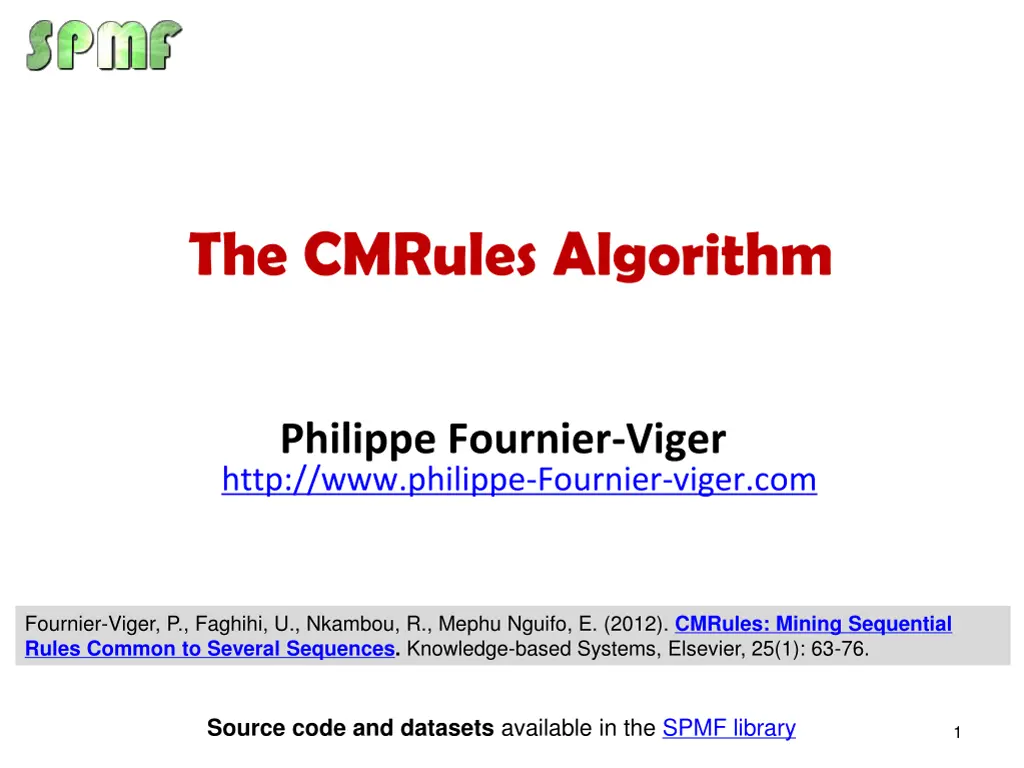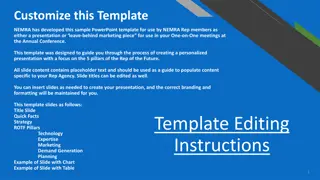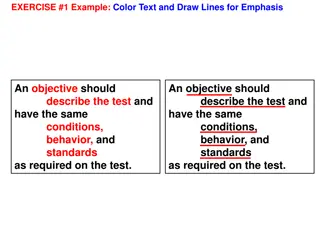
Discover Sequential Rule Mining with CMRules Algorithm
"Learn about sequential rule mining with the CMRules algorithm, which helps analyze sequences to find interesting patterns. Understand the concepts of discrete sequences, itemsets, and sequence databases for pattern discovery."
Download Presentation

Please find below an Image/Link to download the presentation.
The content on the website is provided AS IS for your information and personal use only. It may not be sold, licensed, or shared on other websites without obtaining consent from the author. If you encounter any issues during the download, it is possible that the publisher has removed the file from their server.
You are allowed to download the files provided on this website for personal or commercial use, subject to the condition that they are used lawfully. All files are the property of their respective owners.
The content on the website is provided AS IS for your information and personal use only. It may not be sold, licensed, or shared on other websites without obtaining consent from the author.
E N D
Presentation Transcript
The CMRules Algorithm Philippe Fournier-Viger http://www.philippe-Fournier-viger.com Fournier-Viger, P., Faghihi, U., Nkambou, R., Mephu Nguifo, E. (2012). CMRules: Mining Sequential Rules Common to Several Sequences. Knowledge-based Systems, Elsevier, 25(1): 63-76. Source code and datasets available in the SPMF library 1
Introduction More and more data! A need to analyze data to find interesting patterns Pattern mining: using algorithms to find interesting patterns in data. An important type of data is sequences. Today, we will discuss how to analyze sequences to find sequential rules using the CMRules algorithm. 2
What is a discrete sequence? Sequence: an ordered list of symbols Sequence of purchases Computer Monitor Router Sequence of words you going? Where are 3
Definition: Items Let there be a set of items (symbols) called ?. Example: ? = {?,?,?,?,?,?,?} ? = apple ? = dattes ? = bread ? = eggs ? = cake ? = fish ? = grapes 4
Definition: Itemset An itemset is a set of items that is a subset of ?. Example: {?,?,?} is an itemset containing 3 items {?,?} is an itemset containing 2 items Note: an itemset cannot contain a same item twice. An itemset having ? items is called a k-itemset. 5
Definition: Sequence A discrete sequence ? is a an ordered list of itemsets ? = ?1,?2, ,?? where ?? ? for any ? {1,2..?} Example 1: ?,? , ? is a sequence containing two itemsets. It means that a customer purchased ????? and ????? at the same time and then purchased ????. Example 2: ? , ? ,{?} 6
Definition: Sequence Database A sequence database is one or more sequences. SID 1 2 3 4 sequence <{a}, {a,b,c} {a, c} {d} {c, f}> <{a, d}, {c} {b, c} {a, e}> <{e, f}, {a, b} {d, f} {c}, {b}> <{e}, {g}, {a, f} {c} {b}, {c}> Here we have four sequences. Each sequence has a unique sequence identifier (SID) We want to find patterns revealing strong relationships between items in sequences! 7
Sequential Rule Mining The goal is to discover rules in sequences. Partially-Ordered Sequential rule: Rule of the form ? ?, where X and Y are itemsets that are unordered, non empty and disjoint. Example: {a,b} {f,g} is a sequential rule 8
Sequential Rule Mining The goal is to discover rules in sequences. Partially-Ordered Sequential rule: Rule of the form ? ?, where X and Y are itemsets that are unordered, non empty and disjoint. Example: {a,b} {f,g} is a sequential rule Interpretation: If we observe a and b (in any order), they will be followed by f and g (in any order) 9
Sequential Rule Mining Partially-Ordered Sequential rule: Rule of the form ? ?, where X and Y are itemsets that are unordered, non empty and disjoint. More examples: {} {a,b} {a} is NOT a sequential rule {f} is NOT a sequential rule 10
How to find interesting sequential rules? A sequential rule X Y has two properties: Sequential support sup(X Y): the number of sequences where X occurs before Y, divided by the number of sequences. Sequential confidence conf(X Y): the number of sequences where X occurs before Y, divided by the number of sequences where X occurs. The task: finding all valid rules, rules with a support and confidence not less than user- defined thresholds minSup and minConf (Fournier-Viger, 2010). 11
An example of Sequential Rule Mining Let say that minSup= 0.5 and minConf= 0.5: A sequence database Some rules found 12
Not an easy problem! Let s say that there are r distinct items in a sequence database, that is|I| = r. We can prove that the number of potential sequential rules is: Thus, we do not want to explore all the possibilities! 13
The CMRules algorithm This is the first algorithm for this problem. The key observation is that sequential rules are a type of association rules. CMRules perform two phases: CMRules first applies an association rule mining algorithm such as Apriori to find association rules. Then, CMRules eliminates association rules that are not sequential rules. 14
Association Rule Mining A transaction database D is a set of transactions T={t1,t2 tm} where t1,t2, ,tn I. Association rule: X Y such that X,Y I, X Y= , The support of a rule X Y is defined as sup(X Y) / |D|. The confidence of a rule is defined as conf(X Y) = sup(X Y) / sup(X). Association rule mining: finding all rules such that their support and confidence are no less than some thresholds minsup and minconf. 15
The Relationship between Association Rules and Sequential Rules A sequence database S can be transformed into a transaction databaseS by removing time information. Each sequential rule r: X Y of S has a corresponding association rule r : X Y in S . The relationships holds: sup(r ) sup(r) conf(r ) conf(r), 16
The CMRules algorithm see the article for the proof of correctedness. 17
A Sample Execution of the CMRules algorithm 18
Optimizations How to calcultate thesupport of a sequential rule X Y ? The na ve approach is to check all sequences. Association rule mining algorithms first find frequent itemsets X and Y and then generate rules of the form: X Y-X Algorithms such as AprioriTID, Eclat, H-Mine, etc. can annotate itemset X and Y with the sequences that contains them. If we use such algorithm, we can only check sequence containing X for calculating sup(X Y) . This can improve performance by up to 50 %. Also, we don t need to keep the association rules. We can discard each rule immediately after it is found if it is not a sequential rule. This reduces memory consumption. 19
Analysis of the Time Complexity Step 1: converting a sequence database in a transaction database is done in linear time. Step 2: association rule mining. Two substeps: 1. Discovering frequent itemsets (2?) r= number of diff. items 2. Generating association rules from frequent itemsets: less costly, thus can be ignored. Step 3: calculating sequential conf. and support. For each rule, best case: |S| minsup sequences to check, worst case: |S| sequences to check. Checking if a rule is included in a sequence is done in linear time. 20
Conclusion Summary CMRules: an algorithm for mining sequential rules common to several sequences. CMRules can discover sequential rules and association rules at the same time Advantage: can reuse the code of existing association rule mining algorithms Some more efficient algorithms have been proposed such as RuleGrowth, ERMiner Source code and dataset in the SPMF library 21






















